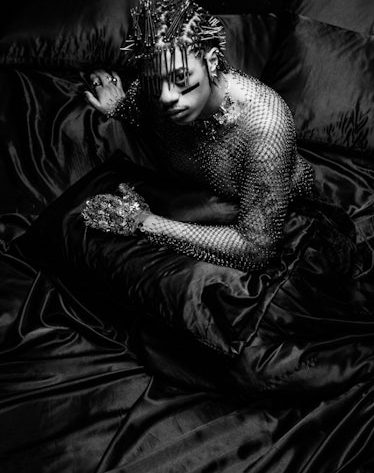Teezo Touchdown remembers the first time he realized that it was music and fashion, not football, that was going to be his future. Being raised in East Texas, “football player” may have been stamped on a Black baby’s forehead, but Teezo had other ideas. He was in middle school, and the Oklahoma drill—a football practice technique developed by University of Oklahoma coach Bud Wilkinson that pins players against each other to test physical contact—proved to be too intense for the budding adolescent. First, he forgot to put his chin strap on, a big mistake in the eyes of his screaming football coach. After that mishap, he lined up with a kid who was the same size as him and ended up with his ankles at his ears. “The next day I signed up for the band,” Teezo recollects. “I didn’t want to get hit like that. I played the trombone. It took me all the way to college at Prairie View A&M. I was on Drumline.”
While his music isn’t at what could be its greatest point—the production on songs like “Impossible” veers too closely to bubbly homage as opposed to sincere disruption—it appears that Teezo, 30, made the right decision to join the band and not line up on the 25 yard line. We’re at Republic Studios in Manhattan, and he he’s disarmingly down to earth, signature metal nails in his braids and all. Before starting the interview, he looked at the framed Cash Money Records poster on the wall and started singing “Money to Blow,” a classic for a young millennial. “They were right when they said we were gonna put Drake on every hook,” he says cheekily. He’s in town for New York Fashion Week (popping up front row at shows like Eckhaus Latta) and the celebration of his debut album, How Do You Sleep at Night?, released on September 8 through RCA Records. This has been a long time coming for Teezo and his fans. After his appearance on “Run It Up” on Tyler, the Creator’s 2021 acclaimed album, Call Me If You Get Lost, the industry has been itching to hear what Teezo’s own project would sound like. “I had been working on this record all the way up to now,” he explains. “There were a bunch of different versions. I see myself as self-deprecating and self-sabotaging sometimes. So, one thing I learned was how to be collaborative, and I studied other debut albums. Like Nelly, Destiny’s Child, and 50 Cent. I’m extending my hand and saying, ‘Nice to meet you, I am Teezo Touchdown.’”
It is tempting to call Teezo an eccentric, but that is a dubious description for a kid who grew up listening to Paul Wall, Slim Thug, pop punk acts, and Prince. He’s more of a borrower of different popular sounds. To see Teezo is to see the promise of music that brings communities together like the fantastical promise of integration. Called an “alien” by Tyler, the Creator himself, Teezo is ambidextrous on How Do You Sleep at Night?, which ventures from hyperpop to R&B to hip-hop and funk, sometimes disjointedly, but with impressive ambition nevertheless. (Be prepared for “Too Easy,” which sounds like it could have been a part of an opening act for Queen). Anyone who has ever had a YouTube tab open to both The Beatles and Odd Future music videos at the same time will have their eyes pop in excitement while listening to his album. “I call my genre rock and boom,” Teezo says. “It’s combining rock music, boom bap for hip-hop, and R&B. Rock and boom.”
Still, Teezo has his share of detractors. Pitchfork dubbed him as the “insufferable fashion rapper of the moment” back in 2021, when he fronted a Heaven by Marc Jacobs campaign. Hip-hop fans have a right to be annoyed by artists using rap as a business plan for other creative heights. The genre stands alone; it doesn’t exist to bolster an artist’s financial portfolio. But, being into fashion is not inherently a bad thing, and hip-hop has been aligned with the industry since Dapper Dan of Harlem sold his custom-made clothing to Run DMC. For Teezo, fashion is one more pillar of hip-hop—each informs the other. “I’m giving the mesh of hip-hop. I can’t be jacking anyone. I got to be fly. I got to write my own stuff,” Teezo said. “One of the books I have read was The Big Payback—a book about the commercialization of hip-hop. So, I don’t view hip-hop as just sonics. It’s everything to me.”
Teezo is precociously observant. At one point, he notes that journalists are “very impartial,” and laughs at my proper demeanor like the boyish and playful charmer that he is. It’s that charm, maybe, that’s landed him in rooms with some of the biggest names in music. Drake recently posted Teezo on Instagram and hyperbolically claimed that he “just heard some of the best music ever.” While a cynic might look at his friend group, which casually includes music industry heavyweights like Drake, Janelle Monae, and Tyler, the Creator, and call it social climbing, Teezo says that it’s not just clout that makes people gravitate toward him. “I think what is happening with me is that people notice my craft,” he says. “Meeting new people is the benefit from my pen, my appreciation for media, and knowledge of music.”
Teezo says he is all about learning from the legends. He wants to meet mega producer Teddy Riley, the original beacon of the new jack swing sound, because he thinks that it is similar to plugg—the dreamy and laidback subgenre of trap music—sound, plugg, sound with the chord progressions. To him, Riley would be someone that communicates an almost romantic feeling to him; the moment where a young man starts to blossom into a real artist. He notes, “I’m all about going to the source.”



